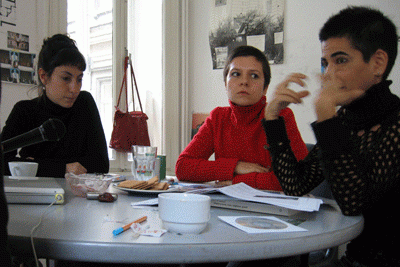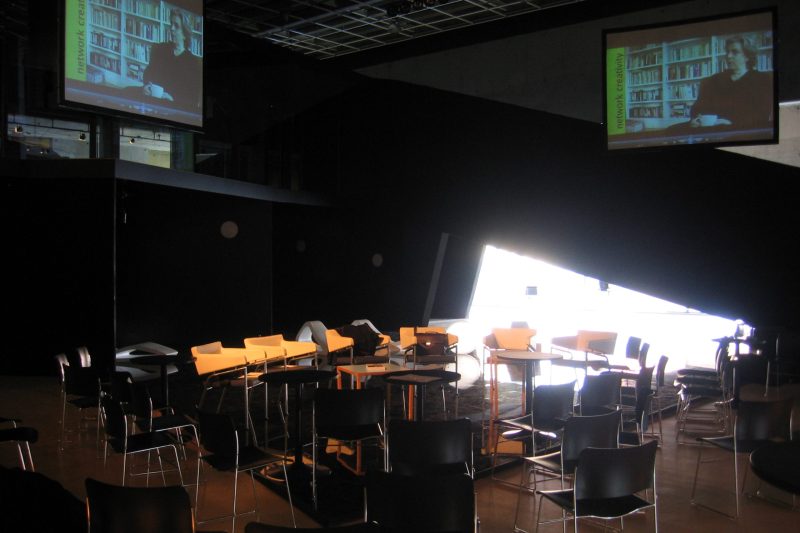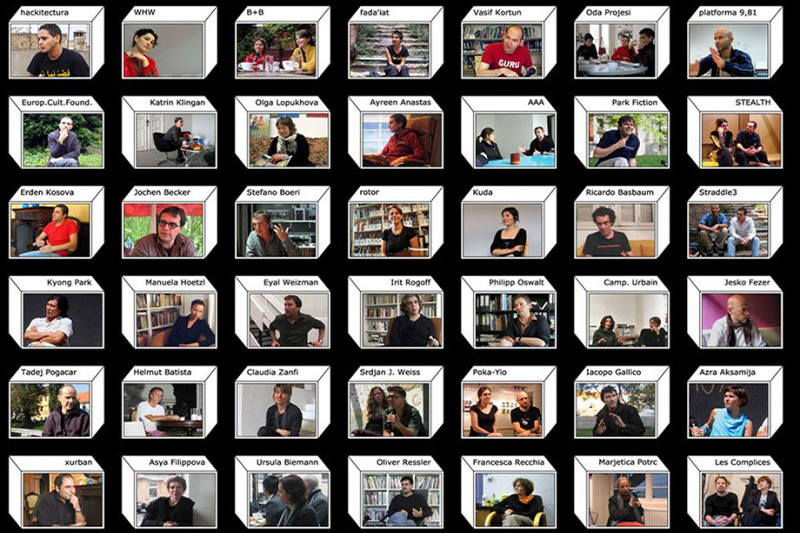- Interview
- Istanbul
- 11.07.2005
- NETWORKED CULTURES
Conversation with Erden Kosova
PM/HM: Leaps of Faith is the name of a group show you curated together with Katarina Gregos in the divided city of Nicosia. What impact did the location have on your curatorial approach?
Erden Kosova: Nicosia is renowned as the last divided city in Europe and the residents of both parts have lost their visual memory of the other side of the city. One of the main objectives of our exhibition was to facilitate circulation between the Greek and Turkish part of the city. We wanted people to move about in both parts, and so we encouraged and invited people to at least walk back and forth. The gates were opened in April 2003, but for political or psychological reasons people were still reluctant to go to the other side. Our idea was to stimulate an interest in architectural knowledge on site, and to focus on an artistic practice that could be negotiated between the different actors and create a discursive organism. We organised a film programme, bringing in works from other regions that had similar political situations, and so offered aesthetic models for comparisons between Cyprus and other locations. Lebanon, Beirut, Israel and Palestine are all near the island, just twenty minutes away by airplane. Nevertheless, there is little interest in relating to these neighbours east of Cyprus. Which is why we wanted to raise interest in political engagement of this kind and so we organised some talks within this framework. Almost all the artists presented their works at the Goethe Institute, which is located in the buffer zone, in the UN-controlled corridor between the two territories.
This was the first international contemporary art exhibition of this scale on the island. Yet, it was a humble exhibition, put together with limited resources, without support from any official local institution. It’s difficult to foresee the long-term effects of the exhibition. At some point, the connections established between the two sides and between circles in each area should organise themselves and work towards certain objectives. Intellectual interventions from the outside cannot do more than facilitate existing forces. When you work as a curator, how can you avoid reproducing preconceived ideas and representational conceptions of the site and try to channel them into something else? It’s a big ethical challenge to use a space that has remained unused for thirty-one years after a traumatic rupture. But I think there’s always a way to talk about the rupture, about the other, to transform a specific memory, performatively speaking, in a progressive way. Of course, there’s the risk of failing, of producing new exoticisms and representational ideas, but there’s also the possibility of generating productive discussion about these contested spots.
PM/HM: How do these political and curatorial experiences relate to your own background, that is, to the politically oriented art scene in Istanbul in the late 1990s?
Erden Kosova: I belong to a generation in Istanbul that emerged around 1998-1999. Local networking was full of accidental motivations, but also political ones. We sought ways to express our energy, and then there were other like-minded people and if they found some space, some location to meet, things developed very fast. This was the case in 1998 when a kind of collective spirit evolved locally. At the time, nobody from this young constellation was invited to international art exhibitions. So we just sat around at home talking about art practices, but then at some point things took off. European art institutions somehow discerned this energy, appropriated it to the global circuit and suddenly artists started to produce works for specific exhibitions. The works were not produced for empty studios, they were produced for exhibitions to which the artists were invited.
So, people got caught up in a different speed, things became more structured and standardised, and this had, of course, positive and negative consequences. The same thing happened to me. Through my collaboration in Graz with < rotor > gallery, I found constellations of people from nearby geographical locations who had similar concerns and experiences. We were from the same generation, we saw the same cartoons as children, we made the same jokes, we were in love with the same football players. We had different mother tongues but we had similar concerns, ways of thinking, similar political interests. I somehow insisted on keeping in touch with what I had found, and people on the other side were also pleased with collaborating with what I represented, my stories, my perspective of reading artists. I slowly started to see their perspectives too, and then I had the opportunity to travel and to produce things with them. So, there was a kind of gradual expansion of perspective, a networking.
PM/HM: You spoke about the energy of Istanbul as one of the key factors in shaping the local art scene. Thinking about the current urban explosion taking place in Istanbul, what are the implications of this accelerated growth and urban segregation, and how does it relate to new forms of cultural expression?
Erden Kosova: There’s this popular argument that Istanbul was never modern, but went directly from the pre-modern to the post-modern. The logic behind this is based on the notion of a belated modernism that tries to catch up with the standards of other megapolitan cities, but in doing so pursues completely unsustainable and strange projects. The mayor of Istanbul is an architect and he had the idea of putting a huge whirling dervish statue on one of the islands so that it would look like some kind of statue of liberty. It was ridiculed a lot and he had to give up the idea and, instead, a smaller statue, related to Mehmed II, the conqueror of Istanbul, was erected in Kadiköy, in the Asian part of town. The Islamic movement has this obsession with Mehmed II. Why conquer a city over and over again? The agenda on the surface is nationalistic – exalting the heroic past and expressing pride in having captured the historic capital of the Eastern Roman or Byzantine Empire and ushering in a new era. But at the same time, Istanbul has been informed by a very contemporary agenda, one in which newcomers to the city, who see themselves as authentic locals, have literally to conquer Istanbul back from “the Byzantines of the present”, from a more bourgeois and Western-oriented culture.
On the other hand, those who see what is happening as the arrival of a peasant culture that spoils the urban environment are very elitist in their views, and ignore the possibility of hybrid cultures emerging between the urban and what is still in the process of developing an urban identity. “Arabesque” culture was, for example, very important in the 1980s. This culture was not introduced by migrants from cities in Anatolia, nor was it native to Istanbul – it was something else. This music took elements from Egypt, India, Europe and other places. In the Balkans, similar cultural formations emerged. In Serbia, it was called “turbo-folk”; in Bulgaria, “chalga”. It had so-called oriental roots and interrupted the cultural politics of these countries, displacing the official ultra-modernism of the nation states of Yugoslavia or Bulgaria or Turkey. So arabesque music is somehow genuinely urban. But then the mass media struck back, inventing so-called Turkish pop, a form of mainstream music that promotes cultural homogenisation. Yet contrary to the elitist position that condemns arabesque and other similar styles of expression, I would say they provide some vague possibilities for producing new urban formations of subcultures and forms of communications.

Erden Kosova
is an art critic living in Istanbul. As a writer and editor, he has contributed to art-ist and Resmi Gorus, two contemporary art magazines based in Istanbul. Kosova co-authored the book Szene Türkei: Abseits aber Tor! (Jahresring & Walther König, 2004), and he is also a member of the post-anarchist collective that runs the magazine project Siyahi. He recently co-curated ‘Leaps of Faith’, an exhibition that was held in both sections of the divided city of Nicosia in 2005. He currently works for the Istanbul-based socialist newspaper Birgun, and is a PhD candidate at the Visual Cultures Department of Goldsmiths at the University of London.


